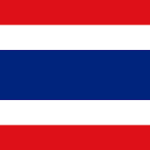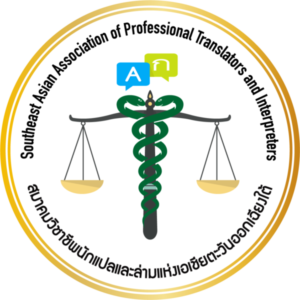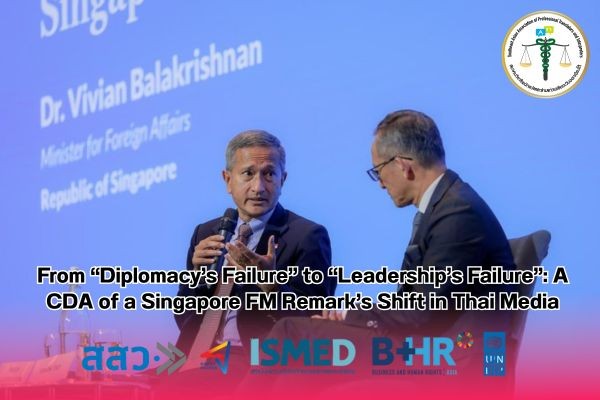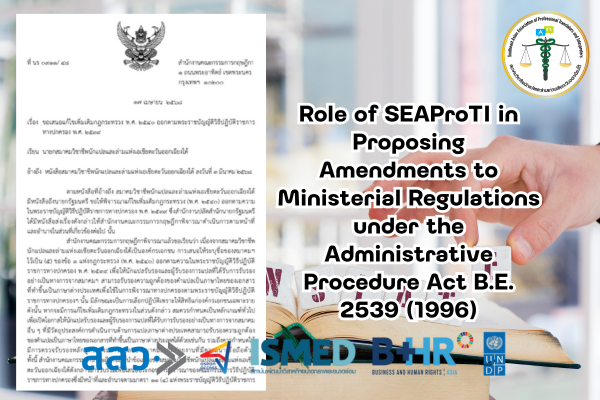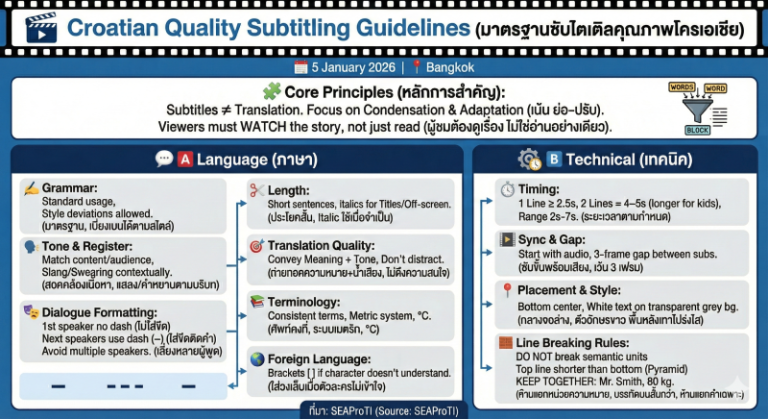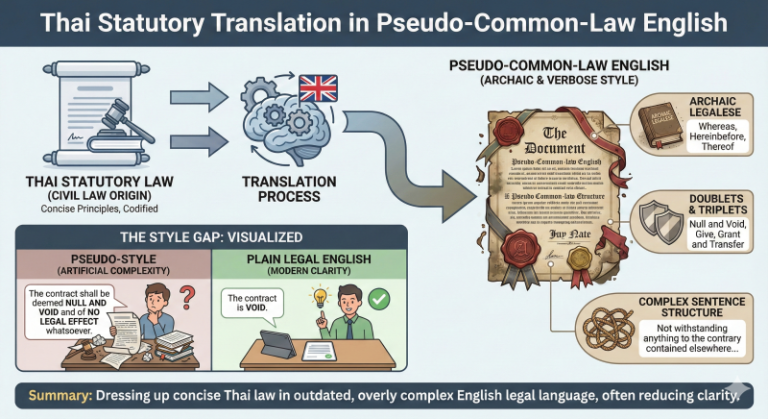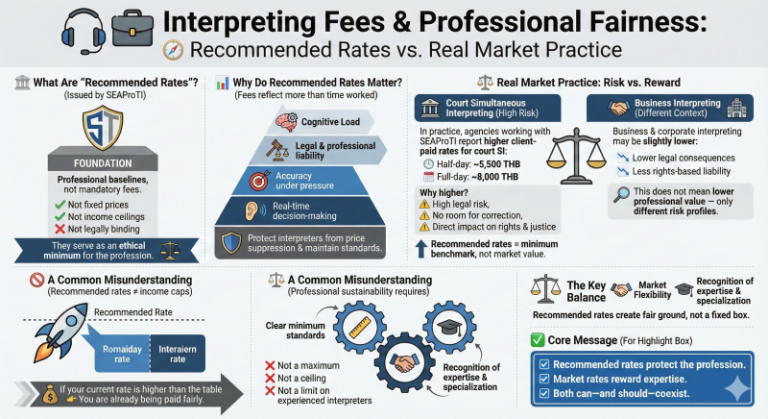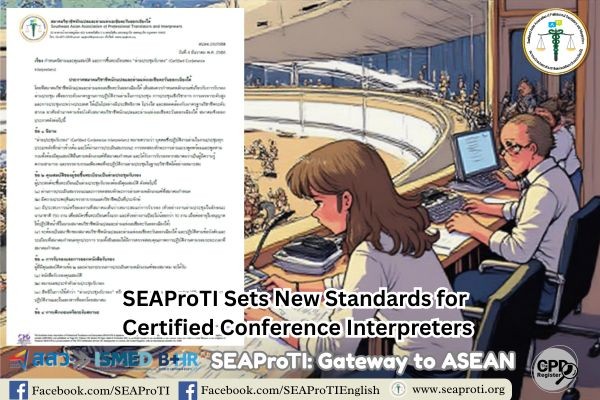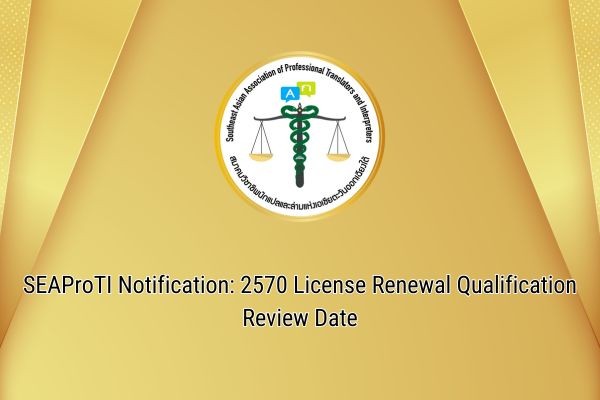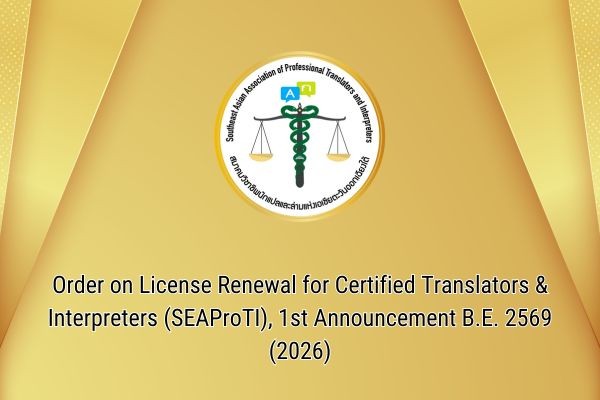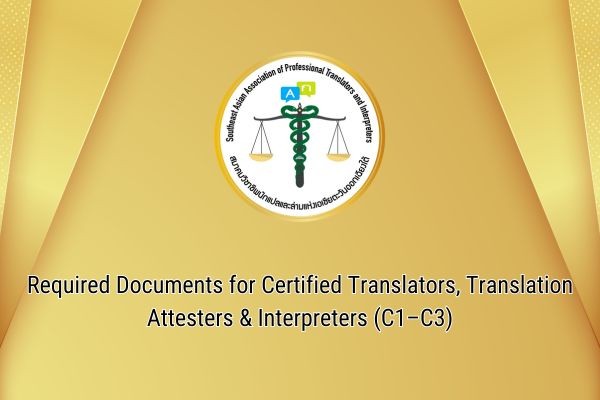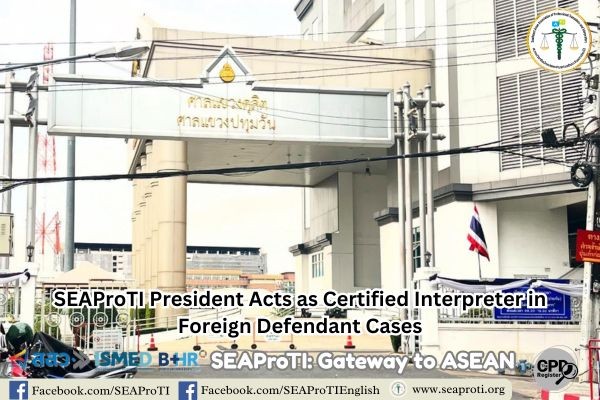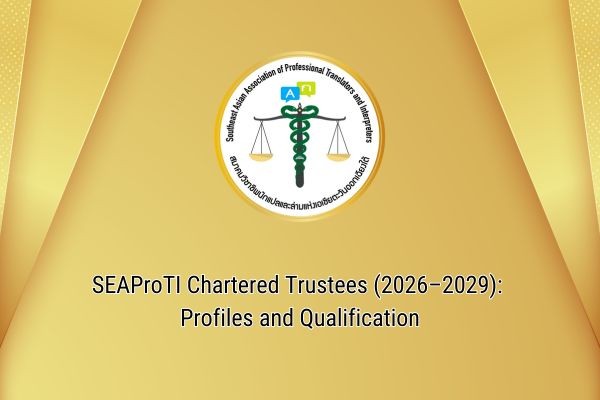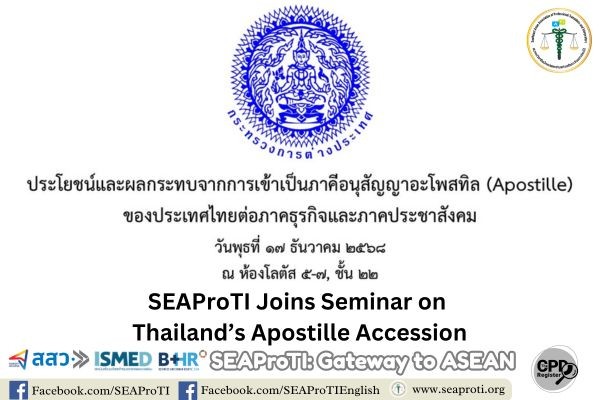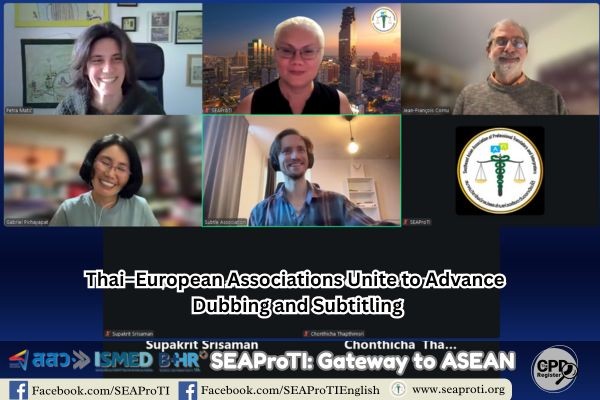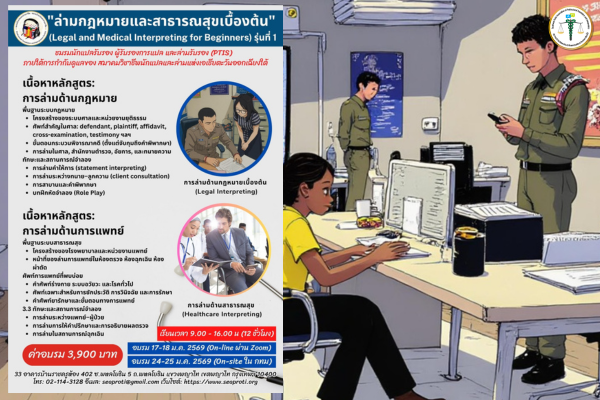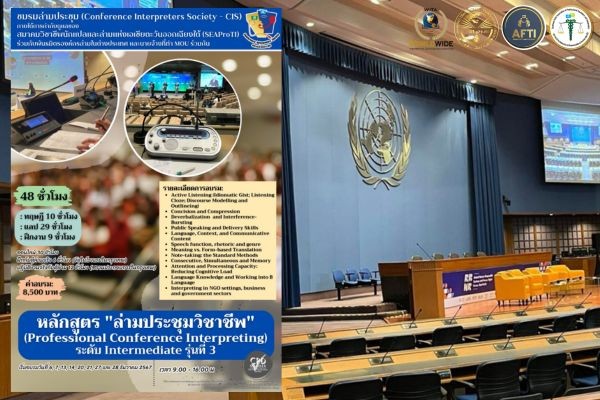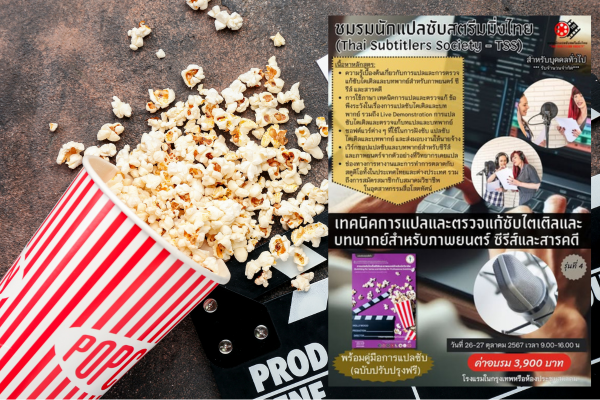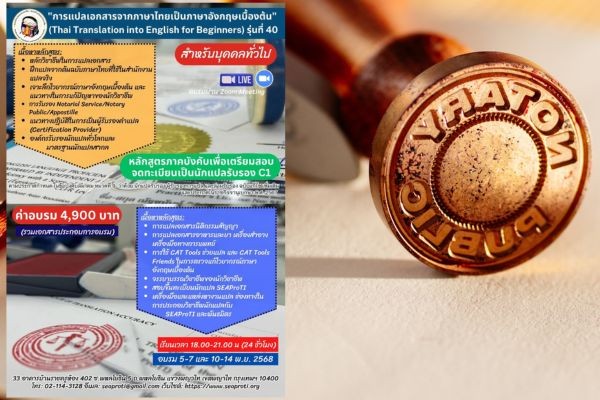From “Failure of Diplomacy” to “Failure of Leadership”:
A Critical Discourse Analysis (CDA) of Singaporean Foreign Minister Dr. Vivian Balakrishnan’s Remarks and the Semantic Shift in Thai Media Translation
By Wanitcha Sumanat, President, Southeast Asian Association of Professional Translators and Interpreters (SEAProTI)
9 August 2025, Bangkok – This paper examines a case study in diplomatic communication arising from the Cambodia–Thailand border clashes, applying a Critical Discourse Analysis (CDA) framework to investigate: (1) the original remarks of Dr. Vivian Balakrishnan, Singapore’s Minister for Foreign Affairs, delivered at the 17th ASEAN and Asia Forum; (2) the Thai media’s presentation and mistranslation of “failure of diplomacy” into “failure of leadership”; and (3) the clarification provided by Thailand’s Foreign Minister Maris Sangiampongsa, who emphasised that the remarks did not target any individual leader, but rather pointed to the conditions under which diplomacy can be effective—specifically, when “leadership is unobstructed.”
The analysis finds that lexical choice, narrative framing, and recontextualisation in translation play decisive roles in shaping political perceptions and interstate relations. It also reveals the power dynamics of the media in reframing meaning from a systemic critique to a personalised one, posing risks to ASEAN trust-building and the sustainability of ceasefire and observer mechanisms along the Cambodia–Thailand border.
Background and Empirical Context
At the 17th ASEAN and Asia Forum (Singapore, 5 August 2025), Dr. Balakrishnan described the Cambodia–Thailand clashes as a “major setback” for ASEAN’s credibility and a “failure of diplomacy”, stressing that border disputes “need not escalate into violence.”
In parallel, Thailand and Cambodia agreed to establish an ASEAN observer mechanism to reinforce the ceasefire agreement (Extraordinary GBC Meeting, Kuala Lumpur, 7 August 2025).
On 9 August 2025, Thailand’s Foreign Minister clarified that some Thai media outlets had mistranslated Dr. Balakrishnan’s words as criticism of “leadership,” when in fact his central message was a call for an environment in which leaders can work without obstruction so that “diplomacy can function to its fullest.”
Methodological Framework: Critical Discourse Analysis (CDA)
The study employs Fairclough’s three-dimensional model—(a) text, (b) discursive practice, and (c) social practice—augmented by van Dijk’s ideological square (emphasising “our good” and “their bad”) and Wodak’s Historical-Discursive Approach to situate the analysis in the historical context of border disputes and ASEAN diplomacy.
For translation analysis, the paper draws on shift and recontextualisation (Hatim & Mason) and narrative framing (Baker) to examine how failure and leadership acquire altered semantic prosody through translation and headline production.
Textual Layer: Lexical Choices and Intentionality
- Source Discourse: “Failure of diplomacy” targets systems and processes rather than individuals, paired with the frame “major setback for ASEAN’s credibility”, signalling institutional and regional evaluation.
- Thai Headlines (Recontextualised): Shifted meaning toward “failure of leadership”, moving the focus from system → individual and creating personalisation of blame/responsibility.
- Counter-Discourse (Clarification): The Thai side asserted that Dr. Balakrishnan did not question anyone’s leadership, but described the conditions under which diplomacy works—e.g., “when leadership is obstructed, problem-solving becomes more complex”—resetting the meaning to the level of structural and decision-making conditions rather than personal fault.
Key Finding: Replacing diplomacy with leadership changes the target of critique (system/institution → individual leader) and shifts the level of analysis (regional/institutional → personal politics), increasing the potential for domestic and international political conflict.
Discursive Practice Layer: Platform, Headlines, and Speed
News evidence shows that the mistranslated content was amplified on social media until the “headline version” dominated public perception, before an intervention by Thai diplomatic authorities (direct phone call and authorisation to clarify) restored the original meaning.
This reflects a frame contestation between:
(a) a frame criticising diplomatic systems/ASEAN credibility, and
(b) a frame criticising individual leadership, where social media dynamics tend to favour personalised and affective narratives over institutional facts.
Social Practice Layer: Power, Regional Identity, and ASEAN Mechanisms
At the regional level, the late July–early August 2025 clashes resulted in a ceasefire agreement and ASEAN observer mechanism under Malaysia’s ASEAN chairmanship, supported by external partners calling for strict adherence to the ceasefire.
The “ASEAN credibility” discourse thus became central to diplomatic exchanges, both in affirming ASEAN’s conflict-resolution role and in critiquing its perceived limitations.
Mistranslation: Linguistic Mechanisms and Risks
Semantic Shift
- Failure of diplomacy → failure of leadership: Alters unit of analysis and actor held responsible.
- Introduces stronger negative semantic prosody toward “leadership,” absent in the original.
Newsroom Practices
- Headline economy: Drives clicks with combative narratives.
- Decontextualisation: Omits intent-marking sentences, such as the emphasis on “diplomacy in an environment where leaders can work.”
Diplomatic Risks
- Creates misattribution to a foreign minister.
- Opens space for political weaponisation of remarks in domestic discourse.
- Undermines interstate trust during a period requiring ASEAN ceasefire monitoring.
Recommendations (For Media, Translators, and State Agencies)
- Editorial Offices: Implement dual-check between reporters and language editors before headline publication; attach primary source references (transcript/slides/video) when quoting foreign-language statements.
- News Translators: Clearly identify level of critique (system vs. person) in the target language; avoid over-lexicalisation that intensifies personal attack without source basis.
- State Agencies: Produce rapid-response explainers (bilingual) in frame-contestation situations to realign public perception with the original message.
- Public/Online Media Literacy: Promote awareness of headline-cutting and decontextualisation mechanisms; emphasise verification from primary sources.
Conclusion
The “from failure of diplomacy to failure of leadership” case shows how translation and headline production can construct or dismantle speaker intentionality within a few lines when driven by social media logic and political competition.
CDA reveals across the text–process–social dimensions that word choice and framing directly affect diplomatic trust and ASEAN’s credibility. In contexts reliant on ceasefire and observer mechanisms, preserving terminological accuracy and respecting the original intent is not merely a linguistic concern but a precondition for institutional peace.
References
- Al Jazeera. (2025, August 7). Cambodia and Thailand agree to deploy ASEAN ceasefire monitors.
- Australian Department of Foreign Affairs and Trade. (2025, August 8). Ceasefire deal between Cambodia and Thailand.
- Baker, M. (2006). Translation and conflict: A narrative account. Routledge.
- Fairclough, N. (1995). Critical discourse analysis: The critical study of language. Longman.
- Hatim, B., & Mason, I. (1997). The translator as communicator. Routledge.
- Ministry of Foreign Affairs of Singapore. (2025, August 6). Transcript of Minister for Foreign Affairs Dr Vivian Balakrishnan’s keynote dialogue at SIIA’s 17th ASEAN and Asia Forum (5 Aug 2025).
- Nation Thailand. (2025, August 9). Maris clarifies misinterpretation of Singapore counterpart’s remarks.
- Reuters. (2025, August 7). Cambodia and Thailand agree to ASEAN observers to ensure ceasefire holds.
- Reuters. (2025, August 7). Cambodia and Thailand to hammer out permanent ceasefire in Malaysia meeting.
- Singapore Institute of International Affairs. (2025, August 6). The recent Cambodia–Thailand border clash is a major setback.
- The Associated Press. (2025, August 7). Thailand and Cambodia to deploy ceasefire monitors despite deadlock over captured soldiers.
- The Straits Times. (2025, August 5). Cambodia–Thailand border clash a setback for Asean.
- Thai MFA. (2025, August 7). Joint Press Statement: Extraordinary GBC Meeting, Kuala Lumpur.
- Thai News Agency (MCOT). (2025, August 9). “Maris” clarifies via phone with Singapore FM on misinterpreted remarks.
- van Dijk, T. A. (1998). Ideology: A multidisciplinary approach. SAGE.
- Wodak, R., & Meyer, M. (Eds.). (2001). Methods of critical discourse analysis. SAGE.
About SEAProTI Certified Translators, Certification Providers, and Interpreters
The Southeast Asian Association of Professional Translators and Interpreters (SEAProTI) has published official guidelines and eligibility criteria for individuals seeking registration as Certified Translators, Translation Certification Providers, and Certified Interpreters under Chapter 9 and Chapter 10 of the Royal Thai Government Gazette, issued by the Secretariat of the Cabinet, Office of the Prime Minister, on 25 July 2024 (Vol. 141, Part 66 Ng, p. 100).
Full text available at: Certified Translators, Certification Providers, and Certified Interpreters. The Royal Thai Government Gazette
จาก “ความล้มเหลวทางการทูต” สู่ “ความล้มเหลวของผู้นำ”:
การวิเคราะห์เชิงวาทกรรมวิพากษ์ (CDA) ต่อคำกล่าวของ ดร.วิเวียน บาลากริชนัน และการคลาดเคลื่อนเชิงคำแปลในสื่อไทย
โดย วณิชชา สุมานัส นายกสมาคมวิชาชีพนักแปลและล่ามแห่งเอเชียตะวันออกเฉียงใต้
9 สิงหาคม 2568, กรุงเทพมหานคร – บทความนี้วิเคราะห์กรณีศึกษาการสื่อสารทางการทูตระหว่างเหตุปะทะชายแดนไทย–กัมพูชา โดยใช้กรอบ Critical Discourse Analysis (CDA) เพื่อตรวจดู (1) ถ้อยคำต้นทางของ ดร.วิเวียน บาลากริชนัน รมว.ต่างประเทศสิงคโปร์ในเวที 17th ASEAN and Asia Forum, (2) การนำเสนอและการแปลในสื่อไทยที่บิดเบือนความหมายจาก “ความล้มเหลวทางการทูต” (failure of diplomacy) ไปเป็น “ความล้มเหลวของผู้นำ”, และ (3) การชี้แจงของ มาริษ สงี่ยมพงษ์ รมว.ต่างประเทศไทย ซึ่งย้ำว่าเจตนาของถ้อยคำมิได้โจมตีตัวบุคคล หากแต่ชี้ให้เห็นเงื่อนไขที่ทำให้การทูตทำงานได้เต็มศักยภาพเมื่อ “ภาวะผู้นำไม่ถูกขัดขวาง” ผลวิเคราะห์ชี้ว่า การเลือกคำ (lexical choice), กรอบการเล่าเรื่อง (framing), และ การสถาปนาเจตนารมณ์ผู้พูดผ่านการแปล (recontextualization in translation) มีบทบาทชี้ขาดต่อการรับรู้ทางการเมืองและความสัมพันธ์ระหว่างประเทศ ทั้งยังสะท้อน พลวัตอำนาจของสื่อ ในการแปรความหมายจากระดับ “ระบบ” ไปสู่การ “เหมารวมเป็นตัวบุคคล” ซึ่งเสี่ยงต่อความไว้วางใจในอาเซียนและการคงอยู่ของกลไกหยุดยิงและผู้สังเกตการณ์อาเซียน ณ พรมแดนไทย–กัมพูชา
ฉากหลังและข้อมูลเชิงประจักษ์
บนเวที 17th ASEAN and Asia Forum (สิงคโปร์, 5 ส.ค. 2568) ดร.วิเวียนระบุว่าเหตุปะทะไทย–กัมพูชาเป็น “major setback” ต่อความน่าเชื่อถือของอาเซียน และสะท้อน “failure of diplomacy” พร้อมย้ำว่าข้อพิพาทเขตแดน “ไม่จำเป็นต้องลุกลามเป็นความรุนแรง” ขณะเดียวกัน ไทยและกัมพูชาตกลงจัดตั้งกลไกผู้สังเกตการณ์อาเซียนเพื่อสนับสนุนข้อตกลงหยุดยิง (ประชุม GBC พิเศษ 7 ส.ค. 2568 ณ กัวลาลัมเปอร์)
ต่อมา (9 ส.ค. 2568) รมว.ต่างประเทศไทยชี้แจงว่า สื่อบางแห่งแปลและตีความคำพูดของ ดร.วิเวียน คลาดเคลื่อนเป็นการวิจารณ์ “ภาวะผู้นำ” ทั้งที่ สารหลัก คือ การร้องขอให้เกิดสภาพแวดล้อมที่ให้ผู้นำได้สามารถทำงานได้โดยไม่ถูกขัดขวาง เพื่อให้ “การทูตทำงานได้เต็มที่”
กรอบวิธีวิจัย: Critical Discourse Analysis (CDA)
อาศัยกรอบ สามมิติ ของ Fairclough—(ก) การวิเคราะห์ตัวบท (text), (ข) กระบวนการตีความ/การผลิต (discursive practice), และ (ค) บริบทสังคมการเมือง (social practice)—ประกอบด้วยแนวคิด ideological square ของ van Dijk (การย้ำ “ด้านดีของเรา/ด้านร้ายของเขา”) และ Historical-Discursive Approach ของ Wodak เพื่อมอง การสืบเนื่องเชิงประวัติศาสตร์ ของข้อพิพาทพรมแดนและบทบาทอาเซียน นอกจากนี้ บทความนี้ยังเชื่อมโยงกับบทแปลด้วยกรอบ shift & recontextualization (Hatim & Mason) และ narrative framing (Baker) เพื่อศึกษาว่า คำว่า failure และ leadership มี “ความหมายแฝงเชิงน้ำเสียง หรืออารมณ์ของความหมาย” (semantic prosody) อย่างไรเมื่อผ่านการแปลและพาดหัวข่าวแล้ว
ชั้นถ้อยคำ (Text): เลือกคำเพื่อกำกับเจตนารมณ์
- วาทกรรมต้นทาง (source discourse): “failure of diplomacy” วางน้ำหนักที่ “ระบบ/กระบวนการ” มากกว่าตัวบุคคล และจับคู่กับเฟรม “major setback for ASEAN’s credibility” ซึ่งเป็นการประเมิน “สถาบัน/ภูมิภาค”
- ถ้อยคำไทยบางถ้อยคำในพาดหัวข่าว (recontextualized): ผันความหมายไปสู่ “ความล้มเหลวของผู้นำ” ซึ่งโยกศูนย์กลางจาก “ระบบ” → “ตัวบุคคล” และสร้าง personalization ของความผิด/ความรับผิด
- ถ้อยคำชี้แจง (counter-discourse): ไทยชี้แจงว่า ดร.วิเวียน มิได้ตั้งคำถามต่อผู้นำ แต่กล่าวถึง เงื่อนไข ที่ทำให้การทูตทำงานได้ (เช่น “เมื่อภาวะผู้นำถูกขัดขวาง และเกิดการแก้ปัญหาซับซ้อน”) ซึ่งรีเซ็ตความหมายกลับสู่ระดับ “โครงสร้างกับเงื่อนไขของการตัดสินใจ” ไม่ใช่กล่าวโทษปัจเจกบุคคลใดบุคคลหนึ่ง
ข้อค้นพบย่อย: การแทนที่ diplomacy ด้วย leadership เปลี่ยนไป ผู้ถูกวิจารณ์ (จาก “ระบบทูต/สถาบัน” → “บุคคล/ผู้นำ”) และเปลี่ยน ระดับการวิเคราะห์ (จากภูมิภาค/สถาบัน → การเมืองตัวบุคคล) ซึ่งเพิ่มศักยภาพความขัดแย้งทางการเมืองภายในและต่างประเทศ
ชั้นปฏิบัติการสื่อสาร (Discursive Practice): แพลตฟอร์ม, พาดหัว, และความเร็ว
- หลักฐานเชิงข่าวบ่งชี้ว่าเนื้อหาถูก เผยแพร่และขยายความบนโซเชียล จนความหมาย “ฉบับพาดหัว” ครอบงำการรับรู้สาธารณะ ก่อนมี “การแก้กรอบ” โดยผู้มีอำนาจทางการทูตของไทย (จากบริบท “โทรศัพท์หารือ” หรือ “มอบอำนาจชี้แจง”) ซึ่งคือ intervention เพื่อกู้ความหมายต้นฉบับกลับมา
- ผลคือ เกิด การช่วงชิงกรอบความหมาย (frame contestation) หลายฝ่ายพยายามกำหนดหรือตีความ “กรอบ” (frame) ของเหตุการณ์หรือประเด็นหนึ่ง ๆ ให้เป็นไปตามมุมมองของตน จนเกิดการแข่งขันกันว่ากรอบใดจะครองการรับรู้ของสาธารณะ ระหว่าง (ก) กรอบ “วิจารณ์ระบบการทูต/ความน่าเชื่อถืออาเซียน” กับ (ข) กรอบ “วิจารณ์ตัวผู้นำ” ซึ่งแพลตฟอร์มโซเชียลมีแนวโน้มส่งเสริมเนื้อหาที่ personalized/affective มากกว่าข้อเท็จจริงเชิงสถาบัน
ชั้นปฏิบัติการสังคม (Social Practice): อำนาจ อัตลักษณ์ภูมิภาค และกลไกอาเซียน
ในระดับภูมิภาค เหตุปะทะปลายเดือนกรกฎาคมจนกระทั่งถึงต้นสิงหาคม 2568 นำไปสู่ ข้อตกลงหยุดยิงและกลไกผู้สังเกตการณ์อาเซียน ภายใต้บทบาทประธานอาเซียนของมาเลเซีย และการยืนยันร่วมของภาคีภายนอกว่า “ต้องค้ำยันกลไกหยุดยิง” ซึ่งทำให้ วาทกรรม “ความน่าเชื่อถือของอาเซียน” กลับมาเป็นหัวใจของการถกเถียงอีกครั้ง
การแปลผิด: กลไกทางภาษาและความเสี่ยง
Shift ทางความหมาย
- failure of diplomacy → ความล้มเหลวของผู้นำ: เปลี่ยน หน่วยวิเคราะห์ และ ตัวผู้รับผิดชอบ
- เพิ่ม semantic prosody เชิงลบรุนแรง ต่อ “ผู้นำ” ทั้งที่ต้นทางวิจารณ์ “ระบบ/เงื่อนไข”
ปัจจัยด้านรูปแบบข่าว
- พาดหัว (headline economy) กระตุ้นการคลิกด้วย narrative เชิงปะทะหรือเน้นโจมตี
- การยกคำ/ตัดตอน (decontextualization) ทำให้หายไปซึ่งประโยคกำกับเจตนา เช่น การเน้น “สันติวิธีในสภาพแวดล้อมที่ผู้นำทำงานได้” ในคำชี้แจงของฝ่ายไทย
ความเสี่ยงเชิงการทูต
- สร้าง misattribution ต่อเจ้าของถ้อยคำต่างประเทศ
- เปิดช่องให้เกิด political weaponization ของคำพูดในพื้นที่สาธารณะภายในประเทศ
- บั่นทอน ความไว้วางใจระหว่างรัฐ ในช่วงที่ต้องพึ่งกลไกหยุดยิงและผู้สังเกตการณ์อาเซียนอย่างยิ่ง
ข้อเสนอเชิงปฏิบัติ (สำหรับสื่อ นักแปล หน่วยงานรัฐ)
- สำหรับกองบรรณาธิการ: ใช้ dual-check ระหว่างนักข่าว–บรรณาธิการภาษา (editor–translator) ก่อนขึ้นพาดหัว; แนบ บรรทัดยืนยันแหล่งที่มาของข่าวต้นทาง ทุกครั้งที่อ้างถ้อยคำต่างประเทศ (เช่น transcript/สไลด์/วิดีโอ) โดยอ้างอิงหน้าทางการของหน่วยงาน (เช่น MFA สิงคโปร์)
- สำหรับนักแปลข่าว: ระบุ ระดับเป้าหมายของการวิจารณ์ (system vs. person) ให้ชัดในภาษาเป้าหมาย; หลีกเลี่ยง over-lexicalization ที่เพิ่มน้ำหนักโจมตีตัวบุคคลโดยไม่มีฐานจากต้นฉบับ
- สำหรับหน่วยงานรัฐ: จัดทำ rapid-response explainer (สองภาษา) เมื่อเกิดภาวะ “frame contestation” เพื่อดึงความหมายกลับสู่ต้นฉบับ (เช่นกรณีการแถลงชี้แจงของไทย 9 ส.ค.)
- สำหรับผู้ชมทั่วไป/สื่อสังคมออนไลน์: ส่งเสริม media literacy ต่อกลไกการพาดหัว–ตัดตอนและตัดแปะ และให้ความสำคัญกับ แหล่งอ้างอิงปฐมภูมิ มากกว่าการตีความทุติยภูมิ
บทสรุป
กรณี “จากความล้มเหลวทางการทูต → ความล้มเหลวของผู้นำ” แสดงให้เห็นว่าการแปลและการพาดหัวสามารถ สถาปนา/สลายเจตนารมณ์ของผู้พูด ได้ภายในไม่กี่บรรทัด เมื่อถูกผลักดันโดยตรรกะของแพลตฟอร์มโซเชียลและการแข่งขันทางการเมือง กรอบ CDA ทำให้เห็นทั้งมิติ ถ้อยคำ กระบวนการ และสังคม ว่า การเลือกคำ และ การจัดกรอบ ส่งผลต่อความไว้วางใจทางการทูตและความน่าเชื่อถือของอาเซียนโดยตรง ในสถานการณ์ที่ต้องพึ่งพา กลไกหยุดยิงและผู้สังเกตการณ์อาเซียน การรักษาความแม่นยำของคำและการเคารพเจตนาของต้นฉบับ ไม่ใช่แค่ประเด็นภาษาศาสตร์ แต่คือ เงื่อนไขเพื่อสันติภาพเชิงสถาบัน
เอกสารอ้างอิง
- Al Jazeera. (2025, August 7). Cambodia and Thailand agree to deploy ASEAN ceasefire monitors.
- Australian Department of Foreign Affairs and Trade. (2025, August 8). Ceasefire deal between Cambodia and Thailand.
- Baker, M. (2006). Translation and conflict: A narrative account. Routledge.
- Fairclough, N. (1995). Critical discourse analysis: The critical study of language. Longman.
- Hatim, B., & Mason, I. (1997). The translator as communicator. Routledge.
- Ministry of Foreign Affairs of Singapore. (2025, August 6). Transcript of Minister for Foreign Affairs Dr Vivian Balakrishnan’s keynote dialogue at SIIA’s 17th ASEAN and Asia Forum (5 Aug 2025).
- Nation Thailand. (2025, August 9). Maris clarifies misinterpretation of Singapore counterpart’s remarks.
- Reuters. (2025, August 7). Cambodia and Thailand agree to ASEAN observers to ensure ceasefire holds.
- Reuters. (2025, August 7). Cambodia and Thailand to hammer out permanent ceasefire in Malaysia meeting.
- Singapore Institute of International Affairs. (2025, August 6). The recent Cambodia–Thailand border clash is a major setback.
- The Associated Press. (2025, August 7). Thailand and Cambodia to deploy ceasefire monitors despite deadlock over captured soldiers.
- The Straits Times. (2025, August 5). Cambodia–Thailand border clash a setback for Asean.
- Thai MFA. (2025, August 7). Joint Press Statement: Extraordinary GBC Meeting, Kuala Lumpur.
- Thai News Agency (MCOT). (2025, August 9). “มาริษ” แจงโทรเคลียร์ รมว.ต่างประเทศสิงคโปร์ ปมถูกบิดเบือนคำพูด.
- van Dijk, T. A. (1998). Ideology: A multidisciplinary approach. SAGE.
- Wodak, R., & Meyer, M. (Eds.). (2001). Methods of critical discourse analysis. SAGE.
เกี่ยวกับนักแปลรับรอง ผู้รับรองการแปล และล่ามรับรองของสมาคมวิชาชีพนักแปลและล่ามแห่งเอเชียตะวันออกเฉียงใต้
สมาคมวิชาชีพนักแปลและล่ามแห่งเอเชียตะวันออกเฉียงใต้ (SEAProTI) ได้ประกาศหลักเกณฑ์และคุณสมบัติผู้ที่ขึ้นทะเบียนเป็น “นักแปลรับรอง (Certified Translators) และผู้รับรองการแปล (Translation Certification Providers) และล่ามรับรอง (Certified Interpreters)” ของสมาคม หมวดที่ 9 และหมวดที่ 10 ในราชกิจจานุเบกษา ของสำนักเลขาธิการคณะรัฐมนตรี ในสำนักนายกรัฐมนตรี แห่งราชอาณาจักรไทย ลงวันที่ 25 ก.ค. 2567 เล่มที่ 141 ตอนที่ 66 ง หน้า 100 อ่านฉบับเต็มได้ที่: นักแปลรับรอง ผู้รับรองการแปล และล่ามรับรอง
